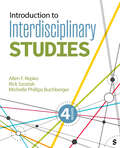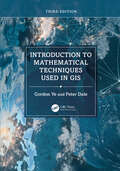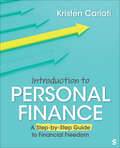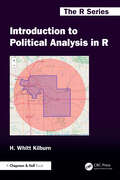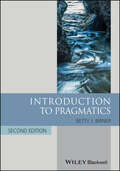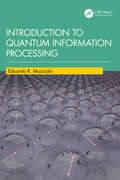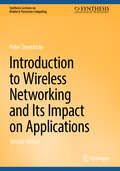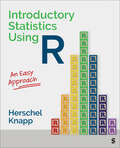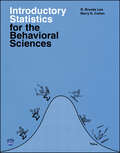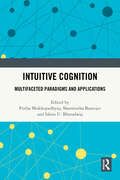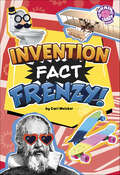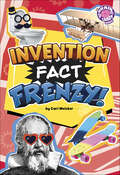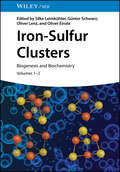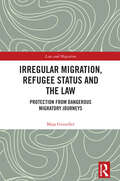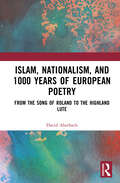- Table View
- List View
Introduction to Interdisciplinary Studies
by Allen F. Repko Rick Szostak Michelle Phillips BuchbergerThis book provides instructors and students in entry-level interdisciplinary courses and thematic programs with a comprehensive introduction to interdisciplinary studies. Authors Allen F. Repko, Rick Szostak, and Michelle Phillips Buchberger introduce students to the cognitive process that interdisciplinarians use to approach complex problems and eventually arrive at more comprehensive understandings of them. Students learn how to think like interdisciplinarians, understand interdisciplinary processes, and assess the quality of their own work. Changes to the Fourth Edition include revised content on epistemology and methods, more on integrative strategies, reordering of some chapters, new assignment ideas, and new examples which include student examples and insights from the latest scholarly works.
Introduction to Interdisciplinary Studies
by Allen F. Repko Rick Szostak Michelle Phillips BuchbergerThis book provides instructors and students in entry-level interdisciplinary courses and thematic programs with a comprehensive introduction to interdisciplinary studies. Authors Allen F. Repko, Rick Szostak, and Michelle Phillips Buchberger introduce students to the cognitive process that interdisciplinarians use to approach complex problems and eventually arrive at more comprehensive understandings of them. Students learn how to think like interdisciplinarians, understand interdisciplinary processes, and assess the quality of their own work. Changes to the Fourth Edition include revised content on epistemology and methods, more on integrative strategies, reordering of some chapters, new assignment ideas, and new examples which include student examples and insights from the latest scholarly works.
Introduction to Mathematical Techniques Used in GIS
by Peter Dale Gordon YeGIS technology and applications have advanced as fast as computing technology to enhance business analytics, predictive modeling, virtual reality, and artificial intelligence. The third edition addresses these new topics of interest to students and practitioners who are using geographic information systems but have a limited mathematical background. Thoroughly updated and reorganized to focus more on applications and problem solving by mathematical techniques, this book explains the basic architecture of computing as it relates to GIS, includes new application examples of selected mathematical methods, and introduces 3D modeling, machine learning, and more.Features Explains the basic mathematics that underpins the manipulation of spatially related data and adds new technology direction such as machine learning. Builds logically step-by-step from simple basic assumptions to real world GIS applications to illustrate mathematical techniques covered in each chapter. Explains computing fundamentals including databases, and modeling techniques such as network modeling and topology overlay. Includes two new chapters focused on how computing relates to mathematics, and new popular applications of GIS which connect with data science and artificial intelligence. Prepares today’s GIS students who do not have STEM backgrounds to follow the thought processes behind the practice of GIS. This textbook is written for those who use global information systems and applications but have a limited mathematical background. It explains the mathematics behind the applications, making it an accessible book for both undergraduate and graduate students in GIS, Computer Science, Geography, and Geomatics.
Introduction to Personal Finance: A Step-by-Step Guide to Financial Freedom (Corwin Mathematics Series)
by Kristen CariotiIntroduction to Personal Finance invites students to reflect on their values and behaviors with money and to set goals to reach financial freedom. Author Kristen Carioti provides clear, step-by-step guidance on the essential building blocks, from setting up an emergency fund, to navigating student loans and investing for retirement. Students are encouraged to evaluate their personal relationship with money and mindfully assess their behavior so they can set and reach achievable financial goals. Watch this video walkthrough and see how Vantage works:
Introduction to Personal Finance: A Step-by-Step Guide to Financial Freedom (Corwin Mathematics Series)
by Kristen CariotiIntroduction to Personal Finance invites students to reflect on their values and behaviors with money and to set goals to reach financial freedom. Author Kristen Carioti provides clear, step-by-step guidance on the essential building blocks, from setting up an emergency fund, to navigating student loans and investing for retirement. Students are encouraged to evaluate their personal relationship with money and mindfully assess their behavior so they can set and reach achievable financial goals. Watch this video walkthrough and see how Vantage works:
Introduction to Political Analysis in R (Chapman & Hall/CRC The R Series)
by H. Whitt KilburnIntroduction to Political Analysis in R is a comprehensive guide for students and researchers eager to delve into the intersection of data science, statistics, and political science. Aimed at equipping readers with the essential quantitative skills to analyze political data, the book bridges practical coding techniques in R with foundational statistical concepts, emphasizing real-world applications in politics.The text adopts a progressive structure, beginning with the basics of R and data manipulation before advancing to more complex topics such as data visualization, spatial analysis, text analysis, and modeling. Through accessible language and engaging examples—ranging from U.S. election forecasting to global development trends—it demystifies complex analytical methods. Each chapter integrates coding exercises and real-world datasets to reinforce learning, fostering independent data analysis skills.Designed for undergraduate political science majors, this book is also a valuable resource for anyone seeking to understand data-driven political analysis, whether for academic research, professional development, or personal curiosity.Key features include: Integrates data science and statistics with a political science focus, offering hands-on coding practice using the R programming language. Provides real-world datasets and step-by-step exercises, enabling students to directly apply concepts to political phenomena such as gerrymandering. Features a progressive chapter structure, progressing from foundational data handling to advanced methods like text analysis, spatial mapping, and linear modeling. Emphasizes accessible coding for beginners, fostering self-sufficiency in data analysis without requiring prior statistical expertise. Bridges theory and application with examples that engage students’ interest in politics while developing transferable analytical skills. H. Whitt Kilburn is Associate Professor of Political Science, Grand Valley State University, Allendale, Michigan.
Introduction to Pragmatics (Blackwell Textbooks in Linguistics)
by Betty J. BirnerA new edition of an essential pragmatics textbook, updated for a new generation of students Introduction to Pragmatics equips students with a comprehensive understanding of how context shapes language, covering both foundational concepts and cutting-edge issues with an interdisciplinary approach. Assuming no previous background in the subject, this student-friendly textbook describes how meaning is created and interpreted. This fully revised new edition addresses contemporary questions surrounding language in society, with increased focus on technological trends and real-world applications of pragmatics. Updated chapters explore politeness theory, presupposition, the boundary between semantics and pragmatics, the pragmatics of linguistic diversity and speech communities, the philosophical background of pragmatics, and the role of language in law, advertising, and politics. Two entirely new chapters on social pragmatics and artificial intelligence (AI) are accompanied by expanded material on noncanonical syntax, information structure, and lexical pragmatics. Offering an ideal balance between theoretical foundations and practical applications, Introduction to Pragmatics, Second Edition: Provides clear and accessible explanations of complex concepts such as presupposition, implicature, inference, and optimality theory Engages with AI and machine communication, exploring the implications for human-language interaction Offers fresh examples, comprehension exercises, and discussion questions to engage students in real-world language analysis Features new case studies that focus on contemporary issues such as politics and propaganda Introduction to Pragmatics, Second Edition, is the ideal textbook for undergraduate and graduate courses in pragmatics and semantics as well as related courses in linguistics and language education.
Introduction to Public Relations: Strategic, Digital, and Socially Responsible Communication
by Janis Teruggi Page Lawrence J. ParnellIntroduction to Public Relations: Strategic, Digital, and Socially Responsible Communication presents a comprehensive introduction to the field of public relations, examining its current practices and future directions. In response to the dynamic shifts in technology, business, and culture, authors Janis T. Page and Lawrence J. Parnell illustrate how today’s PR professionals craft persuasive messages using modern technologies while working in line with the industry′s foundations. The text skillfully balances this approach by delving into communication theory, history, processes, and practices, demonstrating how these elements can be integrated into strategic public relations planning. Page and Parnell guide students toward becoming socially responsible communicators, where fostering trust and respect with diverse communities is valued over creating the next viral campaign. The Third Edition responds to the rising focus on social responsibility, sustainability, CEO and investor activism, and consumer demand for ethical brands, and addresses these changes with updated content, including new features, recent examples, case studies, and chapter-opening scenarios.
Introduction to Public Relations: Strategic, Digital, and Socially Responsible Communication
by Janis Teruggi Page Lawrence J. ParnellIntroduction to Public Relations: Strategic, Digital, and Socially Responsible Communication presents a comprehensive introduction to the field of public relations, examining its current practices and future directions. In response to the dynamic shifts in technology, business, and culture, authors Janis T. Page and Lawrence J. Parnell illustrate how today’s PR professionals craft persuasive messages using modern technologies while working in line with the industry′s foundations. The text skillfully balances this approach by delving into communication theory, history, processes, and practices, demonstrating how these elements can be integrated into strategic public relations planning. Page and Parnell guide students toward becoming socially responsible communicators, where fostering trust and respect with diverse communities is valued over creating the next viral campaign. The Third Edition responds to the rising focus on social responsibility, sustainability, CEO and investor activism, and consumer demand for ethical brands, and addresses these changes with updated content, including new features, recent examples, case studies, and chapter-opening scenarios.
Introduction to Quantum Information Processing
by Eduardo R. MuccioloThis book introduces quantum computing and quantum communications at the undergraduate level for students in the physical sciences, engineering, and mathematics, assuming no prior knowledge of quantum mechanics. It is a self-contained guide assuming only that the reader is familiar with physics at the college level, calculus (up to and including ordinary differential equations), and some matrix algebra and complex numbers. The book brings the reader up to speed with fundamental concepts in quantum information processing and builds a working knowledge of basic quantum algorithms, quantum error correction, and quantum communication protocols. It covers various models of quantum computation and some of the most common physical realizations of qubits. There is a good number of practice problems and exercises that rely on computer programming with the Qiskit language. The book can be used to prepare students of physics, mathematics, electrical and computer engineering, computer science, optics and photonics, and mathematics for internships and research experiences in quantum information processing, both during and after their undergraduate studies. It also helps those who plan to apply to graduate school and do research in this area. Key Features: Self-contained coverage of quantum computing and quantum communications, from the motivations to the fundamentals and applications, including key concepts and contemporary topics. Contains practice problems and exercises, including some that require programming in Qiskit (the python-based, high-level language for programming quantum computers, adopted by nearly all quantum hardware providers and completely open source). Very light background knowledge assumed, making this book accessible to a variety of majors in the natural sciences, engineering, and mathematics.
Introduction to Wireless Networking and Its Impact on Applications (Synthesis Lectures on Mobile & Pervasive Computing)
by Peter SteenkisteThis book teaches readers how wireless networks work, why some of their properties impact wireless network performance at the application level, and what both network engineers and application developers can do to cope with these challenges. This Second Edition includes key updates on these topics, which have become increasingly important as internet users rely more and more on wireless access links for diverse tasks such as web browsing, video conferencing, interactive games, and data sharing. The author compares and contrasts wireless and wired networks, explaining that users expect high quality performance regardless of how they access the internet, even though wireless networks are much more difficult to build than wired networks. Structured according to the layers in the Internet protocol stack, the book discusses the challenges involved in building wireless networks and the obstacles that can affect their performance in real-world applications. The author also provides strategies for approaching these challenges and obstacles. This Second Edition incorporates new information on several topics, including WiFi and 5G cellular.
Introductory Statistics Using R: An Easy Approach
by Herschel KnappFinally, a textbook that makes it simple to teach and learn introductory statistics using the R software! Herschel Knapp′s Introductory Statistics Using R: An Easy Approach is a jargon-free guide to real-world statistics designed to concisely answer three important questions: Which statistic should I use? How do I run the analysis? How do I document the results? Practical examples presented throughout the text with exercises at the end of each chapter build proficiency through hands-on learning. The student website includes datasets, prepared R code for each statistic in the R Syntax Guide, and tutorial videos. As well as learning statistics, with this text students learn how to convert numeric results into clear, publishable documentation.
Introductory Statistics Using R: An Easy Approach
by Herschel KnappFinally, a textbook that makes it simple to teach and learn introductory statistics using the R software! Herschel Knapp′s Introductory Statistics Using R: An Easy Approach is a jargon-free guide to real-world statistics designed to concisely answer three important questions: Which statistic should I use? How do I run the analysis? How do I document the results? Practical examples presented throughout the text with exercises at the end of each chapter build proficiency through hands-on learning. The student website includes datasets, prepared R code for each statistic in the R Syntax Guide, and tutorial videos. As well as learning statistics, with this text students learn how to convert numeric results into clear, publishable documentation.
Introductory Statistics for the Behavioral Sciences
by Barry H. Cohen R. Brooke LeaThe accessible, hands-on statistics textbook that behavioral science students and instructors trust Introductory Statistics for the Behavioral Sciences is a respected, practical textbook that offers carefully crafted exercises to support the teaching and learning of statistics. This revised eighth edition presents all the topics students in the behavioral sciences need in a uniquely accessible format, making statistics feel relevant and approachable. With fictitious yet realistic examples that reappear throughout the chapter, students can follow a continuous narrative that helps them engage with and internalize the content. User-friendly integration with SPSS software enables readers to gain hands-on experience with the application of theoretical concepts. Exercises at the end of each chapter, with additional practice in the online study guide, give students the repetition they need to fully comprehend the material. After working through this textbook, students will understand, not only the what, but also the why of statistical analysis. Get plain-English explanations of statistical concepts and procedures important in behavioral sciences research Learn from relatable examples and exercises focused on psychology, sociology, and other behavioral science Work through well-crafted exercises designed to enhance your understanding of the material Get clear instructions on how to perform statistical procedures with the industry-standard SPSS software Online resources for instructors include a test bank, chapter quizzes, and PowerPoint slides. Introductory Statistics for the Behavioral Sciences also includes a student website containing additional basic math coverage, math review exercises, a study guide, a set of additional SPSS exercises, and downloadable data sets.
Intuitive Cognition: Multifaceted Paradigms and Applications
by Ishita U. Bharadwaj Pritha Mukhopadhyay Sharmistha BanerjeeThis book is an exhaustive and evidence-based introduction to the concepts of intuitive cognition. It focuses on the foundations of intuitive and other forms of cognition, how it allows the integration of new information with existing knowledge along with their applications in diverse fields like business, teaching, marketing and education. The book examines the co-existence of intuition with deliberate information processing and defines the applicability of intuitive cognition from a multidisciplinary approach. What role does intuition play in driving effort, sensory experience, choices or in taking risks? And how can a greater understanding of intuitive cognition help with decision-making, understanding customers or patients and understanding student needs? It explores the efficacy of the unconscious and other forms of cognition, across multiple domains, such as creative art, education, organization, business and finance, neuro-marketing, artificial intelligence and spirituality.This volume will be useful for scholars and researchers of psychology, neuroscience, cognitive psychology, cognitive sciences, education, organizational behaviour, management studies, philosophy, and literature.
Invention Fact Frenzy!
by Cari MeisterThere’s a INVENTION FACT FRENZY headed your way! Did you know that inventor Thomas Edison held more than 2,000 patents? Or that the first submarine was a rowboat covered in leather? Dozens of bite-size invention facts are paired with fun and unexpected photos, welcoming in even the most reluctant readers. Whether kids are in the mood to browse or to devour a book from cover to cover, even a budding young inventor is sure to learn something surprising as they flip through these pages.
Invention Fact Frenzy! (Fact Frenzy)
by Cari MeisterThere&’s a INVENTION FACT FRENZY headed your way! Did you know that inventor Thomas Edison held more than 2,000 patents? Or that the first submarine was a rowboat covered in leather? Dozens of bite-size invention facts are paired with fun and unexpected photos, welcoming in even the most reluctant readers. Whether kids are in the mood to browse or to devour a book from cover to cover, even a budding young inventor is sure to learn something surprising as they flip through these pages.
Invention Fact Frenzy! (Fact Frenzy)
by Cari MeisterThere&’s a INVENTION FACT FRENZY headed your way! Did you know that inventor Thomas Edison held more than 2,000 patents? Or that the first submarine was a rowboat covered in leather? Dozens of bite-size invention facts are paired with fun and unexpected photos, welcoming in even the most reluctant readers. Whether kids are in the mood to browse or to devour a book from cover to cover, even a budding young inventor is sure to learn something surprising as they flip through these pages.
IoT and AI-Enabled Healthcare Solutions and Intelligent Disease Prediction
by Bhoopesh Singh Bhati Dimple Tiwari Nitesh Singh BhatiThe book presents fundamental to advanced concepts of AI and IoT in healthcare and disease prediction, demonstrating the emerging mechanisms, including machine learning, deep learning, image sensing, and explainable AI models to handle issues in healthcare industries with real-life scenarios. Included chapters are contributed by experienced professionals and academicians who examine severe diseases, applications, models, tools, frameworks, case studies, applications, and best practices in Healthcare. This book integrates the medical domain with AI technology. It covers trending explainable AI, computer vision (CV), and IoT that facilitate automation for healthcare solutions and medical diagnostics. The primary focus on explainable AI uncovers the black box of deep learning and bridges the distance between medical professionals and technologists. IoT in Healthcare: provides a mechanism of image sensing and is helpful in surgical tools.
IoT and Advanced Intelligence Computation for Smart Agriculture
by Mourade Azrour Jamal Mabrouki Sultan AhmadSmart agriculture is an approach to maintaining nature without compromising the basic needs of future generations while at the same time improving the efficiency of farming. The main achievements of smart agriculture in terms of sustainable agriculture are crop rotation, controlling nutrient deficiencies in crops, pest and disease control, recycling, and water harvesting, leading to a safer environment overall. Living organisms depend on the nature of biodiversity and are exposed to pollution due to waste emissions, use of fertilizers and pesticides, degraded dead plants, and so on. The emission of greenhouse gases affects plants, animals, humans, and the environment; hence, this necessitates a better environment for living organisms.The purpose of this book is to provide a comprehensive overview of the latest advancements, challenges, and potential applications of artificial intelligence (AI) technology and the Internet of Things (IoT) in the future of intelligent agriculture. The book is primarily focused on equipping younger researchers, graduates, and professionals in the industry with the necessary knowledge to understand the advantages of AI technology, machine learning, and data analytics methods in improving current agricultural practices.Key features include the following: The book showcases the latest advancements in AI and smart agriculture technologies The text emphasizes sustainable practices supported by AI, highlighting how technology can enhance productivity while minimizing environmental impact Readers will learn how to harness big data and analytics to drive informed decision-making and optimize their agricultural yields
IoT, Blockchain, and Smart Healthcare: Integration Techniques and Case Studies (Innovations in Health Informatics and Healthcare)
by Manoj Kumar Mazdak Zamani Rohit Tanwar Neelu Jyothi Ahuja Urmila PilaniaThe book examines the integration of Internet of Things (IoT), blockchain, and smart healthcare, providing a comprehensive analysis of these advanced technologies and their impact on the healthcare industry. It offers practical examples of how blockchain and IoT devices can be used to address real-world healthcare challenges and overcome the hurdles of implementing them in the healthcare sector.IoT, Blockchain, and Smart Healthcare: Integration Techniques and Case Studies provides a detailed exploration of how these technologies are combined, giving readers a deep understanding of their role in revolutionizing healthcare. It explores the practical applications of blockchain and IoT devices in solving healthcare problems and addresses the challenges of incorporating these technologies into healthcare systems. The book also provides practical guidance on implementing cutting-edge methodologies, enabling readers to apply theoretical knowledge in real-world situations effectively.By bridging the gap between technology and healthcare, this book makes complex concepts understandable to a wide audience, including healthcare professionals, researchers, technology enthusiasts, and policymakers.
Iron-Sulfur Clusters: Biogenesis and Biochemistry
by Günter Schwarz Silke Leimkühler Oliver Lenz Oliver EinsleAn authoritative and up-to-date collection of resources covering the ubiquitous iron-sulfur cluster-containing proteins In Iron-Sulfur Clusters: Biogenesis and Biochemistry, a team of distinguished researchers delivers an incisive and practical discussion of the assembly and role of metalloproteins containing an iron atom in a mononuclear or binuclear metal-active site, or where the assembly and final activity of the enzyme depends on an Fe-S cluster containing protein. The book examines the crosstalk in the assembly of metal-active sites and the roles played by various metal ions in polynuclear metalloclusters. It also describes metal homeostasis and trafficking in a cellular context and explains why the availability of metal ions is tightly regulated. Of particular interest to chemists working with iron-sulfur (Fe-S) clusters in biology, biochemistry, pharmaceuticals, and drug synthesis, the book also contains: A thorough introduction to the biosynthesis of hydrogenase cofactors and hydrogenase reaction mechanisms Comprehensive explorations of the reaction mechanisms of molybdoenzymes, including sulfite oxidase, aldehyde oxidase, and formate dehydrogenase Practical discussions of the biosynthesis of Fe-S clusters in prokaryotes and eukaryotes Complete examinations of the insertion of Fe-S clusters and the biosynthesis of Moco and FeMoco An overview of the chemical, crystallographic, spectroscopic and theoretical methods commonly used to characterize Fe-S clusters. Perfect for biochemists and protein, pharmaceutical, bioinorganic, and organic chemists, Iron-Sulfur Clusters will also be useful for food and environmental chemists, as well as professionals working in the pharmaceutical industry.
Irregular Migration, Refugee Status and the Law: Protection from Dangerous Migratory Journeys (Law and Migration)
by Maja GrundlerThrough an investigation of the protection needs of ‘irregularised migrants’, this book offers a novel approach to the phenomenon of irregular migration by reframing it as a matter of refugee law.Thousands of people have died, disappeared and suffered mental and physical harm on their dangerous migratory journeys to Europe. This book addresses an issue which, so far, has been largely omitted from the study of refugee law: the fact that harm experienced during irregular migration is often as serious as harm feared by recognised refugees in their countries of origin. Grundler argues that harm experienced during dangerous journeys can constitute persecution and that a risk of irregular re-migration can form the basis for a claim to refugee status. Drawing insights from a comparative content analysis of trafficked persons’ asylum claims, other disciplines such as psychology and sociology and additional case law, this book provides readers with new understandings on the scope of the refugee definition, adds new concepts to migration theories and challenges states’ migration control policies.This volume will be an important point of reference for scholars, practitioners, policymakers and students working on refugee and human rights law, (irregular) migration and vulnerability.
Islam, Nationalism, and 1000 Years of European Poetry: From The Song of Roland to The Highland Lute
by David AberbachIslam, Nationalism, and 1000 Years of European Poetry considers the long history of Islam and European poetry and its central importance in the development of European culture.David Aberbach offers a panoramic history of European poetry as it was affected by the centuries-long conflict between Islam and Christianity, from the early-medieval Old French chanson de geste, The Song of Roland, set against the Muslim invasion of France in the eighth century, to Fishta’s The Highland Lute, the early-twentieth-century Albanian epic of the struggle for independence from Ottoman rule, achieved in 1912. Aberbach surveys some of the outstanding poetry set against Islamic conquests and domination, particularly in Spain and the Balkans. The book includes detailed comparisons between medieval and modern Arabic and Hebrew poetry, closely linked in technique and subject matter, but moving apart after 1789. A result of constant religious warfare in Europe was disillusionment with religion, increasing focus on humanistic concerns, and the evolution of a secular State separate from religion.This captivating history of Islam and European poetry will be of great interest to any scholars of nationalism, Jewish and Islamic Studies, history, comparative literature, and cultural studies.
Islamic Economics, Growth and Development (Islamic Business and Finance Series)
by Mustafa Metin BaşbayThe study of economic development is inherently grounded in philosophical and ethical assumptions. In other words, to discuss economic development either at a conceptual level or as a real process necessitates an ethical and philosophical basis. The authors of this book believe that Islamic economics can serve as such a basis, one that emanates from Islamic principles and values.This book presents a distinctive ethical and philosophical framework, one that is grounded in Islamic principles and the established literature of Islamic economics and finance, to analyse and interpret the concept of economic development, as well as to propose policy solutions to real-world development problems and challenges. The book contains theoretical and empirical studies, which connect the literature of Islamic economics with economic development. While some chapters discuss development at the conceptual/philosophical level, others examine the real-world issues faced by developing countries. It proposes institutional constructs as well as concrete public policies to face developmental challenges, such as fighting poverty and inequality, environmental and social sustainability, industrialisation and industrial policy and social services and human capital.Serving as both an introduction and a comprehensive resource, this book illustrates how the concepts and problems of economic development can be examined from an Islamic economics perspective, and, as such, will equip researchers and students with a basic understanding of how Islamic economics interacts with the issues of economic development.
